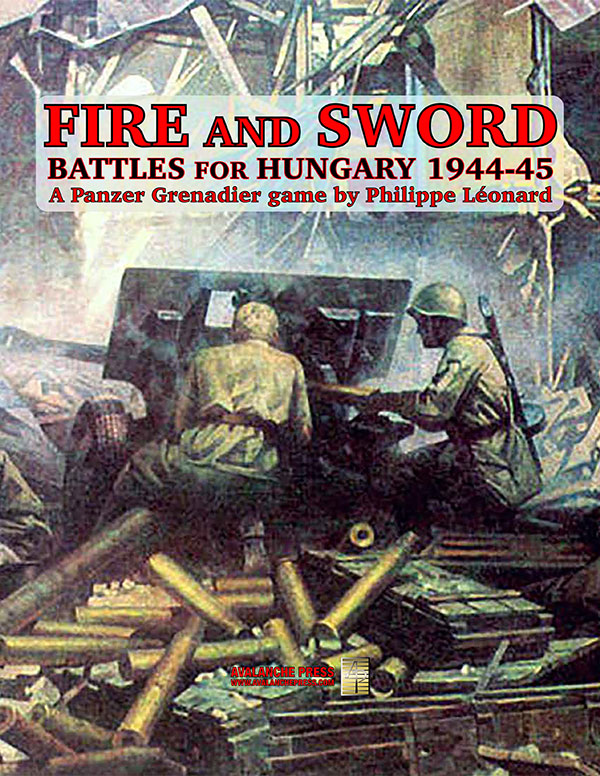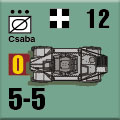| Fire & Sword:
The
Curse of Turan
By Mike Bennighof, Ph.D.
February 2024
 So great, brave nations fought determinedly
for her So great, brave nations fought determinedly
for her
Until the Magyar finally emerged as the bloody
victor
Oh, but discord remained in the souls of
the nations: the land
Can never know happiness, under this curse’s
hand
- Mihály Vörösmarty
In the year 1000 A.D., Hungary's King Stephen
converted his people to Christianity. According
to Magyar legend, a taltos of the old religion
(a shaman, male or female, born with six
fingers on one hand and thus possessing phenomenal psychic
powers) cursed his people for a thousand
years. Having backed the Nazi invasion of
the Soviet Union, by 1944 Hungary found itself on the losing side and the Curse
of Turan lay heavy on the minds of many Hungarians.
The Hungarian Second Army fought north of
Stalingrad and was utterly destroyed during
the winter months of 1942 and 1943. Afterward,
Hungarian troops provided security behind
the German lines but saw little fighting
at the front.
That changed as the war came to Hungary.
Throughout 1943 the Hungarians trained new
forces while Hungarian industry struggled
to provide enough equipment for two field
armies, including three armored divisions.
In August 1943 the Hungarians signed a secret
treaty with the British and Americans, pledging
to allow free passage of Allied bombers through
Hungarian airspace in exchange for the Allies
refraining from bombing Hungarian targets.
The Allied bombing campaign did not begin
until March 1944, and the Germans immediately
noticed that no bombs fell inside the kingdom,
while Hungarian fighter squadrons failed
to scramble after passing enemy bombers.
Meanwhile, the Hungarians denied repeated
German requests to place Luftwaffe fighters
at Hungarian airbases and refused to transfer
Allied air crews who parachuted into Hungarian
territory to German custody.

Hungarian hussars in Poland, 1944.
Note the tomahawk carried by one trooper.
Afraid that Hungary would switch sides (and
angered that Hungarian authorities had refused
repeated demands to hand over the kingdom's
Jews for slaughter) the Germans executed
their "Operation Margarethe" to
seize control of Hungary. Planned in September
1943 following Italy's defection from the
Axis, Margarethe called for German troops
to take control of railroads, airfields and
radio stations.
Before sending in the troops, Adolf Hitler
summoned the Regent of Hungary, Adm. Miklos
Horthy, to a meeting in Salzburg together
with the Army chief of staff, foreign minister
and defense minister. After screaming at
the Hungarians, Hitler threatened them with
imprisonment if they did not consent to immediate
German occupation of their country. German
troops moved in the next morning, with only
a handful of small incidents of resistance.
Hungary's army, the Royal Honved, had spent
a year in re-organization but remained very
weak in modern weapons and particularly in
motor vehicles. The Hungarians hoped to re-equip
eight infantry divisions, an armored division
and a cavalry division as well as two mountain
brigades and some reserve divisions. Each
would be much larger than the divisions sent
into Russia in 1942 or German divisions of
1944: They would have three infantry regiments
of three battalions each, an assault gun
battalion with 30 vehicles, 66 light and
30 heavy anti-tank guns, and an artillery
regiment with 48 guns. The 2nd Armored Division
would have a very similar organization to
a German panzer division, with 143 tanks;
1st Armored Division would be kept at cadre
strength awaiting enough equipment to enter
combat itself.
After their takeover, the Germans promised
to provide the weapons and vehicles, though
not the ammunition, to achieve this
mobilization plan. Hungarian plants had been
turning out weapons for the German armed
forces for several years, and the Hungarians
wanted some of these diverted for their own
use. The Germans, for their part, wanted
to move a number of these factories or at
least their machine tools to Germany.
Hungary built its own tanks, copies of outdated
Czech designs that were badly outmatched
by the newest Soviet models (and most of
the older ones, too). Attempts to buy production
licenses for German designs failed; Italy's
Fiat-Ansaldo obtained a license for the PzKpfw
V Panther in February 1943, but the Nazis
demanded 200 million pengö to grant
the rights to either of the Hungarian tank
makers, Manfred Wiess or Ganz-Danubius (Hungary's
gross domestic product in 1944 was 4.4 billion
pengö). Nor would they allow Skoda to
license its T25 design, the so-called Skoda Panther, to the Hungarians despite
the long-standing relationship between Skoda
and Wiess (which already made the Skoda-designed
T22 as the Turan).
The Nazis did promise to provide 25 new
Hetzer tank destroyers per month, but deliveries
fell far short of this level. A handful of
Tiger, Panther and PzKpfw IV tanks were provided
in 1944, but most Hungarian tank units went
to war with their obsolete Turan tanks, and
somewhat less obsolete Zrinyi assault guns.
Hungarian tank production practically ground
to a halt after the German takeover, and
any new vehicles came from German stocks.
When German weapons and vehicles did arrive,
they went directly to units at the front as the
Germans insisted they be used against the
Soviets. They also suspected (probably rightly)
that the Hungarians would hoard them for
future use against the Germans or the hated
Romanians. However, many shipments never
reached Hungarian units, as German troops
diverted them to their own use; no refunds
were issued by the Wehrmacht.
But weaponry was only one problem confronting
the Honved. After the First World War, the
Hungarian army had been limited to 35,000
men and it never really overcame this handicap.
Despite the threat of imminent Soviet invasion,
the 1944 mobilization plan called for about
450,000 men: only about 3 percent of the
country's population, not counting Jews or
ethnic Germans. The economy should have been
able to bear the loss of at least twice that
many men to military service, but the Army's
training establishment could not have handled
such an influx. German aid would have been
needed, and Hungary's leaders (probably
wisely) did not want to expose their
army to such a pervasive German influence.
As soon as the Germans took over, they sent
the Hungarian First Army to join their Army
Group North Ukraine in southern Poland with
four front-line infantry divisions, three
reserve divisions, both mountain brigades
and the armored division. The Hungarians
fought through the spring and summer, joined
in June by the 1st Cavalry Division and in
August by another corps with two infantry
divisions.
Romania defected to the Allies in late August,
opening a new front on Hungary's southern
border. Two new field armies, Second and
Third, were mobilized. Second Army had two
regular divisions from First Army and several
reserve formations, while Third Army's units
were all training divisions and brigades.
Large numbers of raw conscripts went almost
directly to the front, and by October over
a million Hungarian soldiers were under arms.

A prototype of the Turan III, with
75mm gun.
Thanks to poor training and armament, Hungarian
divisions suffered terrible casualties and
their leaders watched as the Axis armies
steadily fell back across the Hungarian plains.
On 15 October, Admiral Horthy announced that
Hungary was leaving the war, strongly condemning
the Germans for their failure to keep promises
and damning them for their program of mass murder. The Germans
had begun rounding up Hungarian Jews in May
1944, and between then and July when Horthy
ordered a halt over 400,000 were sent to
camps in Poland and murdered.
Seized by German troops, Horthy refused
demands to abdicate and told them he would
sooner die than appoint Ferenc Szalasi, head
of the fascist Arrow Cross organization,
as Hungarian premier. He broke down and
signed when the Germans threatened to shoot
his son instead. But Szalasi inherited a
rapidly disintegrating military. While the
Germans managed to abort Horthy's plan for
First and Second Armies to defect to the
Soviets as complete units, they could not
stop tens of thousands of Hungarian soldiers
from doing so as individuals. Within weeks
the Royal Honved had effectively ceased to
exist and the Germans began conscripting
Hungarians directly into their own units.
First Army fought on in Slovakia even after
Budapest's fall in early 1945, but it was
a shell as were the divisions directly attached
to German corps. The last order from Army
headquarters was an instruction in late April
that Hungarian troops moving through Austria
and Germany to surrender to American or British
forces were not to repay civilians for the
atrocities visited on the Hungarian population
by the Germans.
Fire & Sword
   
The Royal Hungarian Army sees plenty of action in Panzer Grenadier: Fire & Sword, from the elite paratroopers on down to hastily-raised militia. Hungarian armor is there, with both German- and Hungarian-made tanks, and even Hungarian rocket launchers.
You can order Fire and Sword right here.
Please allow an extra four weeks for delivery.
Sign up for our newsletter right here. Your info will never be sold or transferred; we'll just use it to update you on new games and new offers.
Mike Bennighof is president of Avalanche Press and holds a doctorate in history from Emory University. A Fulbright Scholar and NASA Journalist in Space finalist, he has published an unknowable number of books, games and articles on historical subjects.
He lives in Birmingham, Alabama with his wife and three children; he misses his dog, Leopold.
Want to keep Daily Content free of third-party ads? You can send us some love (and cash) through this link right here. |
